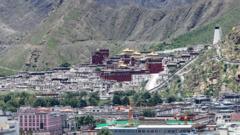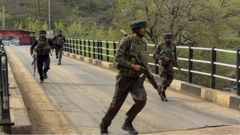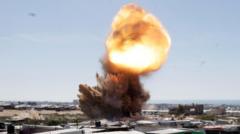At least 32 people have lost their lives, with 38 more injured, following a powerful earthquake that shook the Tibetan region of Shigatse on Tuesday morning. Reports from Chinese state media indicate the earthquake struck around 09:00 local time (01:00 GMT) and was measured at a depth of approximately 10 kilometers (six miles), according to the US Geological Survey. The region experienced several aftershocks post-quake, and the tremors were felt as far as neighboring Nepal and parts of India, underscoring the seismic vulnerability of this area situated on a major geological fault line.
China Earthquake in Tibet Claims Lives and Triggers Humanitarian Response

China Earthquake in Tibet Claims Lives and Triggers Humanitarian Response
A 7.1 magnitude earthquake strikes Tibet, resulting in numerous fatalities and significant damage, raising concerns about future seismic activity.
Shigatse, a key city culturally and religiously significant in Tibetan Buddhism, is recognized as the seat of the Panchen Lama, an important religious figure. Chinese state sources reported a slightly lower magnitude of 6.8, with claims that over 1,000 structures suffered damage. Eyewitness accounts circulating on social media depict buildings collapsing, raising fears of more aftershocks. Jiang Haikun, a researcher at the China Earthquake Networks Center, suggested that while the aftershock sequence may continue, the risk of a more powerful earthquake remains low.
In response to the disaster, the Chinese air force has mobilized resources for rescue operations, deploying drones to assist in the recovery efforts in challenging weather conditions, as temperatures in the region are significantly low. Power and water supplies have been disrupted, complicating relief efforts. Authorities in Nepal reported no casualties or significant damage, even though tremors were felt in the area. Meanwhile, the Tibetan earthquake bureau is still working to confirm the total number of casualties, which may rise as assessments continue.
The earthquake and its aftermath drew attention to the frequent seismic occurrences in the region, which previously endured a catastrophic 7.8 magnitude earthquake in 2015 near Kathmandu, Nepal, leading to nearly 9,000 fatalities and over 20,000 injuries. The current situation has amplified discussions on preparedness and infrastructure stability in earthquake-prone areas, as both local and regional communities brace for potential future seismic activity.
In response to the disaster, the Chinese air force has mobilized resources for rescue operations, deploying drones to assist in the recovery efforts in challenging weather conditions, as temperatures in the region are significantly low. Power and water supplies have been disrupted, complicating relief efforts. Authorities in Nepal reported no casualties or significant damage, even though tremors were felt in the area. Meanwhile, the Tibetan earthquake bureau is still working to confirm the total number of casualties, which may rise as assessments continue.
The earthquake and its aftermath drew attention to the frequent seismic occurrences in the region, which previously endured a catastrophic 7.8 magnitude earthquake in 2015 near Kathmandu, Nepal, leading to nearly 9,000 fatalities and over 20,000 injuries. The current situation has amplified discussions on preparedness and infrastructure stability in earthquake-prone areas, as both local and regional communities brace for potential future seismic activity.




















